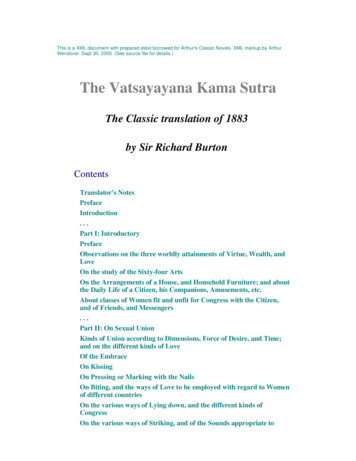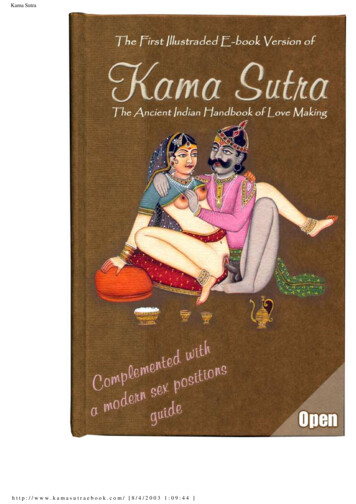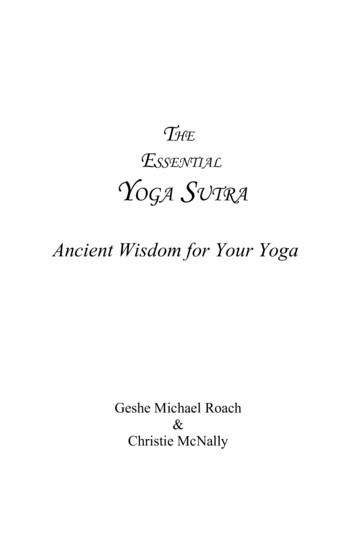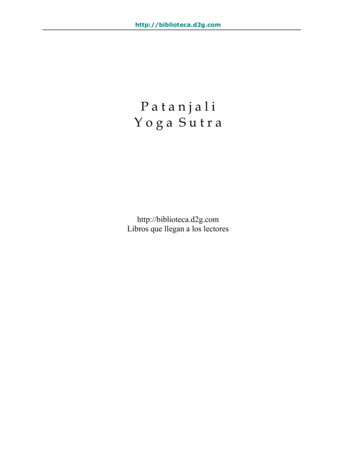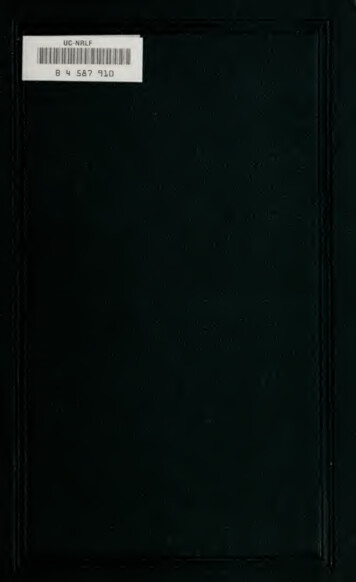
Transcription
HHHHI
THE RALPA SUTRA,ANHA\ A VT A T V A:TWO WORKS ILLUSTRATIVE OF THE JAIN RELIGIONAND PHILOSOPHY.TRANSLATED PROM THE KAGADHI.withAN APPENDIX,CONTAININGREMARKS ON THE LANGUAGE OF THE ORIGINAL.BYTHEREV.J.STEVENSON,D.D.,vim: a . BOMBAY.LONDON:PRINTED FOB THE ORIENTAL TB LNSLATION FUNDOF UBEAT BRITAIN \M» BLELAND;\mi BOLD B1BBBN Ai:IiQTJ i;[TOH,USI'ICCADII.I.V
:rLONDONPRINTED BT HARRISON AND SONS, ST. MARTIN'S LANE,PMNTERS IN OltDINAIlY TO HER MAJESTT. -tff. Acc*rs4 7 f2- -'/
TOLIEUT.-COL W.SYKBS,II.I'.K.S,.M.R.A.S.,LTC, WTO.,IUK/.LAl.'UsPEOMOl BBOFkvi:i;\POi:FHBOWLIGHTTHE &NTIQOITIS8,"N*OB OPEN DP THE BESOUKCES OF INDIA,AniSllN'.tLABOUBEBi-ill.[ IN*Till:flBLDOFORIENTAL RESEARCH,IUKrOLLOWIHGWORKISMOST RESPECTFULLYInm'KIr.r i\Blin-OBLIGEDEUMBL1 BIBYAMT,J.STKVKNSON.a iM151351
PREFACE.IIANSLATOR'STheJains arenowknownwellto the learned inEurope as the only representativesinHindustan ofthe adherents to the tenets of Buddhism, a religiouscommunity oncesoembracing sostillnumerousmanyin India Proper,andof the inhabitants of theDeighbouring countries of Ceylon, Tibet, Burma,China,,anditsadjacent territories.Without thedisparagement to the learned dissertationsleastthat have been published on the Jains, I trust thatthe followin-'most sacredtranslations, the one, that of theirreligious work,and theother, that oftheir most popular philosophical essay, will not heunacceptable to those who take an interestinthehistory of the religious opinions and philosophyolIndia. fthe eightdayHinthe middle of the rainswhich are devoted to the reading of those worksesteemed peculiarly sacred, no l»» thanfiveare
TRANSLATORS PREFACE.VlllKalpa Sutra, theallotted to theof the worksfirsthere presented to the English reader.mences, andwith the legendarychiefly occupied,iscom-Ithistory of Mahavira, the last of those deified spiritual legislators, calledTothis areof theby theappended thesamelives of other four sagesand in some copies those of theclass,whole twenty-four, thoughallof these areexcept thefirst,the precedenceisisit isnearly certain thatand that noneby alater hand,or atany rate thefive toMahavira, by the Jains of thesaid to have died B.C. 663,by those ofBengal, according to Mr. Colebrooke, inby thoseit,whomgiven, are genuine productions ofthe reputed author.Carnatic,Jains, Tirthankaras.B.C.637,in Gujarath, in B.C. 527, or as they state470 years before the commencement of the eraof Vikrama.PartMr. Prinsep in his Useful Tables,II. , p. 33,makesthisevent to have happenedamin B.C. 569, at theage of seventy.inclined to believethe correct date, not only onisThis Iaccount of Mr. Prinsep's great accuracy and tact inallthese matters, but also becauseitagrees bestwith the statement of the Jains, that Mahavira wasthe preceptor of the greatGautama Buddha.The
aTRANSLATORS PREFACE.Ceylonese date of the death of Buddhais543,b.c.and the death of the Tirthankara having takenplaceB.G 569,inof twent-i\ years, for\date embodiedthe reasonable periodthe demise of the preceptoiThe Kalpapupilbefore bisawe obtaininthe workSutra, according toitself,was composed980 years after the demise of Mahavira,Theill.Bay, a.d.public reading of thethatIntroduction.towork tookyears afterwards, as narratedplace twelveisintheThe author's name was Bhadra Bahu,and the sovereign who then reignedwas Dhruva SenaTheinGujarath,four commentators who,between the fifteenth and seventeenth centuries,commented on the work,havewhose ledthe annexedrichandra, the GujarathiYasovijaya,translation,translator chieflyfol-lowed, and Jnanavimala, and Samayasundara.Therebo little of Easternisextravagance exhi-bited intin-age and date of the death ofMahavira,that oneis-I'd for once t" escape exposure to thespiritof Bcepticism which bo generally haunts theEuropeanandt.inhis antiquariangrant the authorallresearchesinIndia.he demands. The name
TRANSLATORS PREFACE.Xof the sovereign reigning in Gujarath at the time,isan important element here,for there aretwoDhruva Senas among the Balabhi monarchs, who,at the period above specified,that part of India.for our purpose,nameTheswayed the sceptrefirst,indeed,isintoo earlybut allowing the second of thatto be in the last year of his reign, as he wellmight, having lost a grown-up son, then on anaverage of twenty-one years to him, and his fourpredecessors,there will be an exactbetween our date of thefirstcoincidencepublic reading of theKalpa Sutra, and that found on the Gujarathcopper-plate grants of thefirstSridhava Sena*accordance with this early date, the state ofzation described in thisworkishigher thanIncivili-we haveany reason to believe has existed among the Hindus,since the first centuries of our era,Brahmanicalliterature, as here depicted,any mention of the Purans, tendsclusion.and theto theThe commentator, indeed,state ofwithoutsame con-in this latter* Dated Samvat 375, i.e., a.d. 318, i.e., 5 x 21 105, which,added to 318, gives 423 411 x 12. There is no such name,Ave may remark, as Dhrava Sena in the modern or restoredBallnira dynasty
TB LtfSLATOBpoint,suppliesthePREFA B\iiomission of the author, andclubs in those modern records of traditions alongwithtin*more ancientstate of thingsitforshowing the altered[tihasa.when hewrote*of course take1granted that the author describes the man-own time andners of hisplace,andthe sixth century before our era atand Rajagriha,hero's pietyworkisand laboursKundagramawhere the scene ofBerar,innot those ofisItLaid.isa pity theso entirely confined to its subject,we have nonethoseofhisandthainotices whichhistoricalrender the Ceylonese MahaVanso so interesting toEuropeans.Iwasatfirstmyinclined to stopremarks onthe history of the Jain religion at this point, andtoconcede that through the natural change towhichallsystemsof opinionare liable,ithadarisen at the period in question from a corruptionof the Buddhistical religion, bu1tothelistof Theros (Sans.aclose attentionSthlravara) or headteachers from Mahavira to the author's time, whichformsa pariofiof the work, especially the unbroken-he chain, andich,tliehasreasonablemade meDumberofhesitate about
TRANSLATORS PREFACE.XUtheof suchcorrectnessan assumption.FromMahavira upwards, indeed, to the preceding Tirthankara Parsvan&th, we have noof headbut we have only an interval of 250teachers,term of Parsva's sublunaryvears, while thetenceliststillisbounded by the possible number ofSoa hundred years.and measuredexis-far the Jains are reasonable,in their eras,mans and Buddhistsfor;compared with Brah-even the latter throwpredecessor back to an immense periodSakya'sbefore the advent of the present Buddha.Themoderation of the Jains, up to the time ofPiirs-vanatha,isthe more remarkable, as after that theyfar outstrip all theirditv,making thecompeers in the race of absur-lives of theirto thousands of years,them countlessages,Tirthankars extendand interposing betweenthus enabling us to tracewith some confidence the boundary between thehistoricaland the fabulous.Thereare,however,yet one or two other points in the accounts theJains give us, which seem to have a historic bearing.Thesistedbetween thefirstisthe relation said to have sublastBuddha andthe last Tir-thankara, the Jains making Mahavira, Gautama's
Ti;preceptor,and him thePREFAC19\ni.and favourite pupil offirstYet theymaster.bisVNSLATOBus that not be, buttellSridharma, became bead of the community afterWhenTirthankara's death.tlifreason they are silent andaversethedisclosetonew andpressedmysterious, evidentlyPactbethatbecame therival sect,whichtime wholly eclipsed their own.Norfounder oflookaany hint offortheforthis kindinfor a longarewetothe writings ofthe Buddhists, as nothing could be said upon thesubject without leading to an avowal that thegreaiSage himself had had anthe Jain theory, however,BuddhaisThefour.inmaymake Mahavlraofbispred inthe presenl —the presentlienoticed, thatre,age.toallKappo he hadconsistentlyJains,theory,evidentlyitsaid to have seen twenty-four of hispredecessors* whilebutIn favour ofinstructor.withtheirhave scon twenty-threethaiexistedbeforehimThis pari of Buddhism thenimplies the knowledge of thetwenty-Gautama, bow-fourTirthankars of the Jains.ever,by the force of natural genius, threw their M;ili;iviiiiMi,lxiokI.,c.i.
—TRANSLATORS PREFACE.XIVsystem entirely into the shade,light ofBuddhism permittedreappear on the Westernthe waningtillits fainterradiance tohorizon""*.Mahavira then, the great hero, as the namewas a Digambara, andimplies, of the Jain religion,went aboutnath,andin-astate of perfect nudity.all hispredecessors, if heParsva-had any, wereclothed in decent apparel, with the single exceptionof BAshabha, ofwhom weshallimmediately speak.Mahavira, no doubt, considered the innovation hehad madein the established system, a reformation,and necessarytosuperiority toallshow theperfect sage's entireworldly feelings and passions.The common sense of Gautamaledhimto see thatthe natural and universal sentiments of mankindcannot be set at nought, or opposed with impunity,and, therefore, hegarments.Itmoved aboutwas notclothed in yellowunlikely, on this very point,that the split took place betweencommunity.Intimes, however, the great majority ofthemother chiefmodernmenhim and theofthe Jain* After writing the above,pated by Mr. Colebrooke, andIfoundam happymyconclusion antici-therefore thatitnowgoes abroad with the suffrage of so learned an Orientalist.Trims. E.A.S., vol.i.,p. 522.
rRANSL ITORS\\u\rvirtuallyconfessedml'l.Ti\vIthe superiorBuddha, by baking a lesson fromwisdom ofandhis [nstitute,wearing plain white garments, (on which accounlthey are called Svetambaras), clothing themselveswithoutcopying the yellow robes of theBervilelyBuddhistpriesthood,Hindu Bairagfs and Gosains,vourmimicry tosectarieswho endea-combine the Buddhistical monkerytoTheBrahmanical theology.practicebarasuchleavingissaidrc\i\ :ilwit hIheof the Digam-by the other party to havetaken place through the efforts of Sahasra Mallika,aboutacentury before the commencement of ourera, sincewhich time the Beets have kept entirelyseparate from one another.ver,from whatisItismuch moresaid above, thatlikelytheSvetam-party originated about that time, and not theItigambara.The secondimagine hasapoint in the Jain traditionshistoricalbasis,iswhichthe accountgive of the religious practice of Rishabha, theof their TirthankaraBaidtohave beenaHe,Digambara.Puranic records, sBrahma-Becond on thekings, in one of the regal families,and said
TRANSLATOKXVIPREFACE.Sto have been father to that Bharat fromtookto havelife,Hename.itsIndiaend ofalso said, in theishisabandoned the world, going abouteverywhere as a nakedascetic.Brahmansthat Jains andhow we canwhomrefusewhere they doso,themseldomIt is soagree, thatdo not seeIcredit in this instancethe only point of differencebetween the two parties being, that while theJams maintain that Bishabha followed aninsti-tute worthy of being adopted by sages in everytheage,onestoutlymaintainthatever thistomaythebe, it is certain thattraditionspreservednoHow-authorized to follow his example.isingBrahmanseven accord-by the Brah-mans themselves, Bishabha, Kapila, Gautama, andother sages,practices,maintained opinions, andwhichvaryorthodox standard, andwas no regular Jainas littlemuch fromif inthefollowedpresentthese early ages thereor Buddhistical organizationwas there an exclusive Brahmanism.Thetruth seems to be, that at the period referred tothere was no regular division of casteamongthe philosophers, nor ofreligionists.All shades of opinionpeople, of schoolssectsamongamong the
TRANSLATORS PREFA and practice were toleratedtheories,the broachers of newand the introducers of newrevile the establishedof the;religion,new notionstheascould not comprehend, and thethe exercise ofthanAndschism.ing,istin'and the adherentsworshipspeculations theynewausterities asintroductionthesuch,may be remarkeditandheresyofin pass-the vcrv view taken of the opinions andpractices ofofnotself-denial they could not reach,aasrites didof elementalsystemVedicoldLooked onratherxvuBairagfsHindus ofand Gosdins by nine-tenthspresent day.tin*After a timehowever, either sectarian zeal became too strongforitspossessorsabstain fromtotaunting thefollowers of the old system with their obtuseness,or the others, alarmednovelties, ran with tireatthe prevalence of theseand sword to the rescue ofthe old superstitions, and thus a schism was perpetrated, which,inwhichinhfieldofatone particular m was established, made Indiaof contentiontoopposing religiousand with the extermination ofthat religionhad been dominant during the period of;i -whichgreat*
TRANSLATORS PREFACE.XV111est glory, occasioned the loss of thosehistoricaldocuments, which recorded the largesses and ex-Daringploits of the sovereigns of a hostile faith.the early ages, the religious warfare in India wascarried on, as far aslegitimate weaponswecan learn, chiefly by theof discussionand argument,though the edicts of Asoka, no doubt, had argu-ments founded on thelogicof the Emperor, aswell as on that of the Dialectician.practice of sacrifice,was prohibited;The openand other Brahmanicalbut there was no reasonrites,for sup-posing that, while the Buddhists had the superiority,they ever so far contradicted the preceptsof their religion as to shed the blood of theirThe same cannot below creatures in a holy war.said of thefel-Brahmans, who themselves admitthat,under the direction of Kumarilla Bhatta, aboutthe eighth century of our era, carnal weapons wereemployedtoput down the Buddhistical and exaltthe Saiva faith.Theoflast division ofmonkishrules, tothe Kalpa Sutraisa digestguide the sages during theParyushana, or Lenten period, a section of the bookwhich requires no remark.Itmaybe useful, how-
TRANSLATORS PREFACE.ever, to exhibitinfew articles the Jain beliefaon those points which toalways1.toxi\European (though notaan Indian
TRANSLATORSPREFACE. a CeylonesedateofthedeathofBuddhaisb.c.543, andthedeathoftheTirthankarahavingtaken placeinB.G569,weobtainthereasonableperiod oftwent\-i\years .
